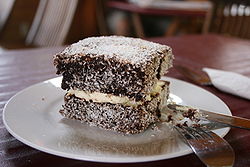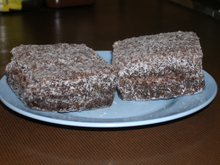- Lamington
-
A lamington is a sponge cake of Australian origin in the shape of a cuboid, coated in a layer of traditionally chocolate icing then desiccated coconut. Lamingtons are sometimes served as two halves with a layer of cream and/or strawberry jam between, and are commonly found in South African and Australasian outlets such as cafes, lunch bars, bakeries, home industries and supermarkets. The raspberry variety is more common in New Zealand, while a lemon variety has been encountered in Australia.[1]
The chocolate coating is a thin mixture, into which cubes of sponge cake (one cookbook states 4 cm per side) are dipped, and the chocolate is absorbed into the outermost layers of the sponge where it sets. (Similarly, the strawberry jam or chocolate icing is absorbed into the sponge.) The cubes are then covered with coconut and left to set.
Contents
History
Most accounts of the creation of the lamington agree it was named after Lord Lamington, who served as Governor of Queensland from 1896 to 1901. One account claims the dessert resembled the homburg hats favoured by Lord Lamington.[citation needed]
However, one claim says they were named after the town of Lamington, South Lanarkshire, Scotland.[2]
Even among those who attribute the name to Lord Lamington, there are many claims as to the exact location and creator of the lamington itself.
According to one claim, Lamingtons were first served in Toowoomba when Lord Lamington took his entourage to Harlaxton House to escape the steamy heat of Brisbane.[citation needed]
Another claim is that the Lamingtons' chef at Queensland's Government House, French Armand Gallad, was called upon at short notice to provide something to feed unexpected guests during the busy period leading up to Federation in 1901. According to the Melbourne Age newspaper, Gallad cut up some left over French vanilla sponge cake baked the day before, dipped the slices in chocolate and set them in coconut. Coconut was not widely used in European cooking at that time, but was known to Gallad whose wife was from Tahiti where coconut was used in cooking. Lady Lamington's guests then asked for the recipe.[3]
A further alternative origin is that Lord Lamington's cook, presumably Gallad, accidentally dropped a block of sponge cake into a dish of chocolate. Later on it was discovered to be very nice with desiccated coconut sprinkled over the top.[4]
Ironically, Lord Lamington was believed to have hated the dessert that had been named in his honour, referring to them as "those bloody poofy woolly biscuits".[5]
Most of these claims are based on relatively recent reports. The earliest identified mention of the lamington is a recipe for the lamington cake published in January 1902, but the identity of the contributor of that recipe was not revealed.[6] While recipes and references to lamington cakes appear over many years subsequent to that, none of them mention the history of the cake or its name. The earliest reference to the naming of cake (located so far) is in October 1933 which attributes it to Lord Lamington.[7]
Modern day
They have traditionally been popular as fund raisers for Australian and South African youth groups such as Scouts, Guides and churches to the extent that such fund raisers are called "Lamington drives".[citation needed] The cake is supplied by commercial bakeries in large slabs and cut into about 40 mm cubes. Teams of volunteers work together, dipping the cake into the chocolate icing and rolling it in the coconut. Generally they are packaged up into one dozen lots for distribution within communities which have been solicited for orders ahead of time. Commercially produced versions are also sold.
Lamingtons have also been popular in Cleveland, Ohio, USA, for many decades. There, they are usually called coconut bars. Some Jewish bakeries in cities with many former Clevelanders, such as Los Angeles, also make them, under various names, such as Cleveland bars and rum bars (when a bit of rum extract has been added to the chocolate icing).
Friday 21 July 2006 was designated as National Lamington Day in Australia.[citation needed]
In September 2006, the National Trust of Queensland named the Lamington one of Queensland's favourite icons.[8]
References
- ^ "Iconic Kiwi Foods, Lamington". http://library.christchurch.org.nz/Reference/FoodDrink/NewZealand/Icons/. Retrieved 2007-12-16.
- ^ "Between Ourselves.". The Australian Women's Weekly (1932-1982) (1932-1982: National Library of Australia): p. 58. 2 July 1980. http://nla.gov.au/nla.news-article46459277. Retrieved 9 April 2011.
- ^ Cosima Marriner, 'Galland attempt to please a Lady takes the Cake' The Saturday Age (6 June 2009): 9.
- ^ "Lamington—The Oz 'National Dish'". Ozwords. Australian National Dictionary Centre. May 1999. http://www.anu.edu.au/ANDC/pubs/ozwords/May_99/6._lamington.htm. Retrieved 2006-10-11.
- ^ Shrimpton, James (6 October 2007). "Australia: The tale of Baron Lamington and an improvised cake". The New Zealand Herald. http://www.nzherald.co.nz/section/7/story.cfm?c_id=7&objectid=10467101. Retrieved 13 October 2011.
- ^ "COOKERY.". The Queenslander (Brisbane, Qld. : 1866-1939) (Brisbane, Qld.: National Library of Australia): p. 30 Supplement: Unknown. 4 January 1902. http://nla.gov.au/nla.news-article21619222. Retrieved 9 April 2011.
- ^ "HONORABLE MENTION.". Sunday Times (Perth, WA : 1902-1954) (Perth, WA: National Library of Australia): p. 2 Section: Second Section. 8 October 1933. http://nla.gov.au/nla.news-article58705639. Retrieved 9 April 2011.
- ^ National Trust: Queensland Icons, 2006, accessed 29 October 2009
External links
Categories:- Australian cuisine
- Australian desserts
- Cakes
- Coconuts
- Foods named after people
Wikimedia Foundation. 2010.



